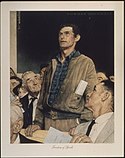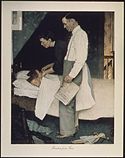Four Freedoms
The Four Freedoms is an important concept of American president Franklin D. Roosevelt. He presented them in the State of the Union of January 6, 1941, which is therefore also called the Four Freedoms Speech.
Roosevelt made the Four Freedoms public just eleven months before the American participation at World War II. The concept played an important role in the American propaganda during the war. After Roosevelts death in 1945, his wife Eleanor continued being an important advocate for including the Four Freedoms in the Universal Declaration of Human Rights.
- "In the future days, which we seek to make secure, we look forward to a world founded upon four essential human freedoms:
- The first is freedom of speech and expression—everywhere in the world.
- The second is freedom of every person to worship God in his own way—everywhere in the world.
- The third is freedom from want which, translated into world terms, means economic understandings which will secure to every nation a healthy peacetime life for its inhabitants—everywhere in the world.
- The fourth is freedom from fear which, translated into world terms, means a world-wide reduction of armaments to such a point and in such a thorough fashion that no nation will be in a position to commit an act of physical aggression against any neighbor—anywhere in the world.
- "That is no vision of a distant millennium. It is a definite basis for a kind of world attainable in our own time and generation. That kind of world is the very antithesis of the so-called new order of tyranny which the dictators seek to create with the crash of a bomb". Franklin D. Roosevelt, January 6, 1941
Art
[change | change source]
To inspire a greater public for his concept, Roosevelt arranged the creation of the Four Freedoms Monument. The statue was made public in 1943 in New York City. In honor of one of the first Americans to be killed in action in World War II, Colin Kelly, Roosevelt had the statue moved to Kelly's former home in Florida.
In 1943 artist painter Norman Rockwell got inspired by the Four Freedoms and made a series of four paintings on this subject. Afterwards, the American authorities made use of these paintings to collect money for the world war.
 |
 |
 |
 |
